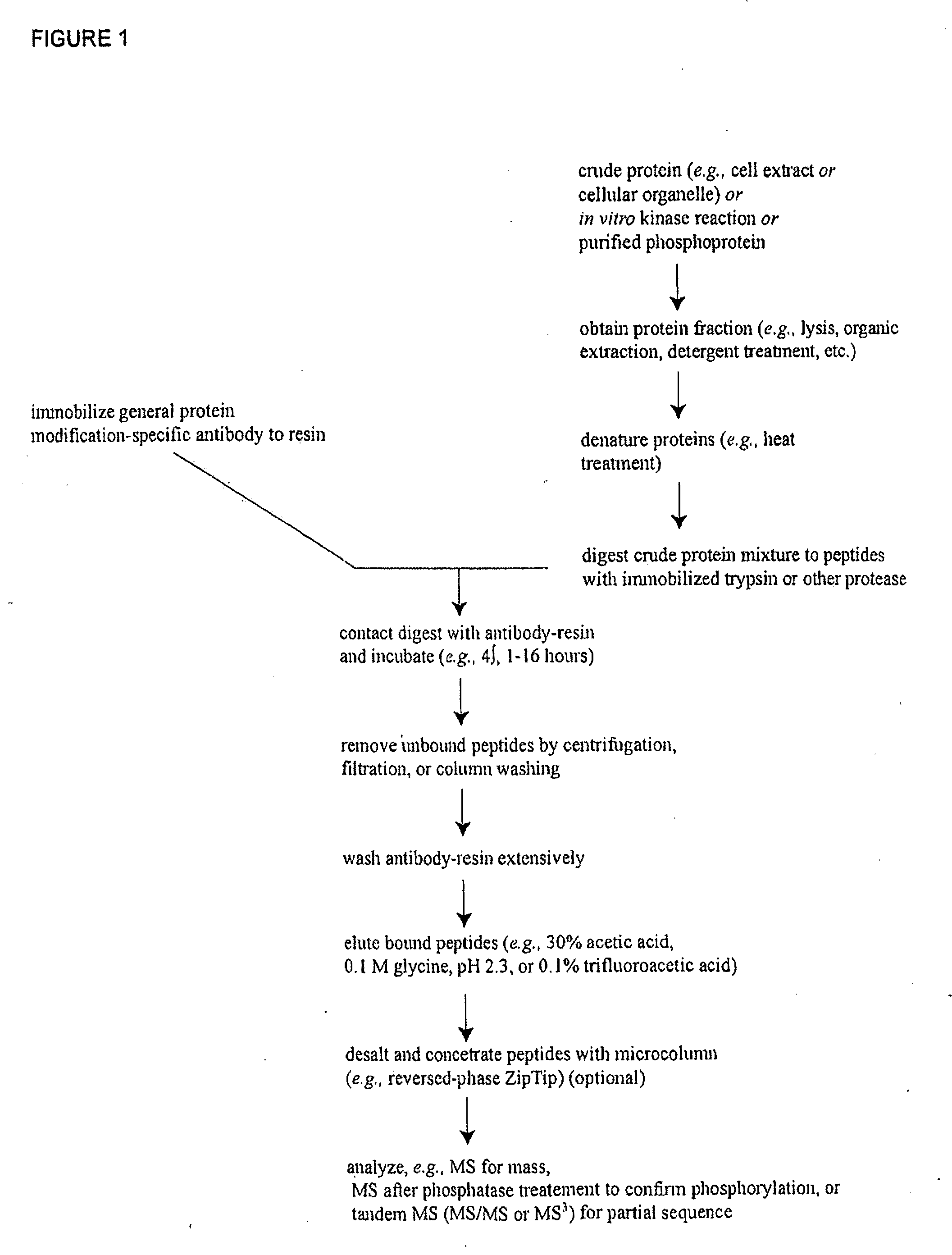Protein phosphorylation by basophilic serine/threonine kinases in insulin signaling pathways
- Summary
- Abstract
- Description
- Claims
- Application Information
AI Technical Summary
Benefits of technology
Problems solved by technology
Method used
Image
Examples
example 1
Isolation of Phospho-Serine and Phospho-Threonine Containing Peptides from Cellular Extracts of Insulin-Responsive Tissue Samples and Identification of Novel Phosphorylation Sites
[0251]In order to discover novel serine and / or threonine phosphorylation sites in insulin-signaling related pathways, IAP isolation techniques were used to identify phosphoserine and / or threonine-containing peptides in cell extracts from cellular extracts from insulin-responsive tissue samples identified in Column G of Table 1 including 3T3-L1; mouse liver; mouse Akt2(− / −) liver Tryptic phosphoserine and / or threonine-containing peptides were purified and analyzed from extracts of each of the cell lines mentioned above, as follows. Cells were cultured in DMEM medium or RPMI 1640 medium supplemented with 10% fetal bovine serum and penicillin / streptomycin.
[0252]Suspension cells were harvested by low speed centrifugation. After complete aspiration of medium, cells were resuspended in 1 mL lysis buffer per 1.25×...
example 2
Production of Phosphorylation Site-Specific Polyclonal Antibodies
[0266]Polyclonal antibodies that specifically bind a novel phosphorylation site of the invention (Table 1 / FIG. 2) only when the serine and / or threonine residue is phosphorylated (and does not bind to the same sequence when the serine and / or threonine is not phosphorylated), and vice versa, are produced according to standard methods by first constructing a synthetic peptide antigen comprising the phosphorylation site and then immunizing an animal to raise antibodies against the antigen, as further described below. Production of exemplary polyclonal antibodies is provided below.
A. Rictor (Threonine 1135).
[0267]A 15 amino acid phospho-peptide antigen, NRRIRTLt*EPSVDFN (SEQ NO:1; t*=phosphothreonine), which comprises the phosphorylation site derived from human Rictor (an adaptor / scaffold protein, Thr 1135 being the phosphorylatable residue), plus cysteine on the C-terminal for coupling, is constructed according to standard...
example 3
Production of Phosphorylation Site-Specific Monoclonal Antibodies
[0274]Monoclonal antibodies that specifically bind a novel phosphorylation site of the invention (Table 1) only when the serine and / or threonine residue is phosphorylated (and does not bind to the same sequence when the serine and / or threonine is not phosphorylated) are produced according to standard methods by first constructing a synthetic peptide antigen comprising the phosphorylation site and then immunizing an animal to raise antibodies against the antigen, and harvesting spleen cells from such animals to produce fusion hybridomas, as further described below. Production of exemplary monoclonal antibodies is provided below.
A. ATG6 (Serine 90).
[0275]A 15 amino acid phospho-peptide antigen, IPPARMMs*TESANSF (SEQ ID NO: 4; s*=phosphoserine), which comprises the phosphorylation site derived from human ATG6 (an adaptor / scaffold protein, Ser 90 being the phosphorylatable residue), plus cysteine on the C-terminal for coup...
PUM
 Login to View More
Login to View More Abstract
Description
Claims
Application Information
 Login to View More
Login to View More - R&D
- Intellectual Property
- Life Sciences
- Materials
- Tech Scout
- Unparalleled Data Quality
- Higher Quality Content
- 60% Fewer Hallucinations
Browse by: Latest US Patents, China's latest patents, Technical Efficacy Thesaurus, Application Domain, Technology Topic, Popular Technical Reports.
© 2025 PatSnap. All rights reserved.Legal|Privacy policy|Modern Slavery Act Transparency Statement|Sitemap|About US| Contact US: help@patsnap.com



